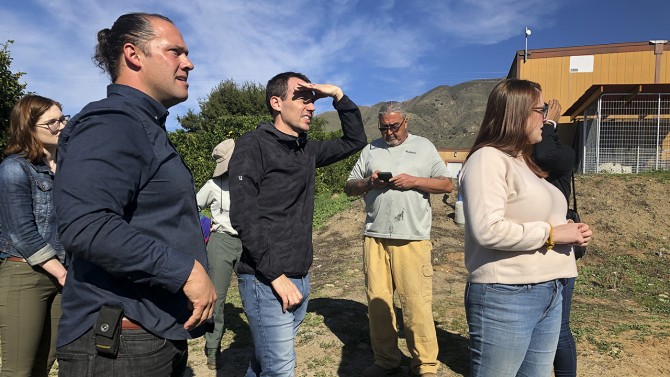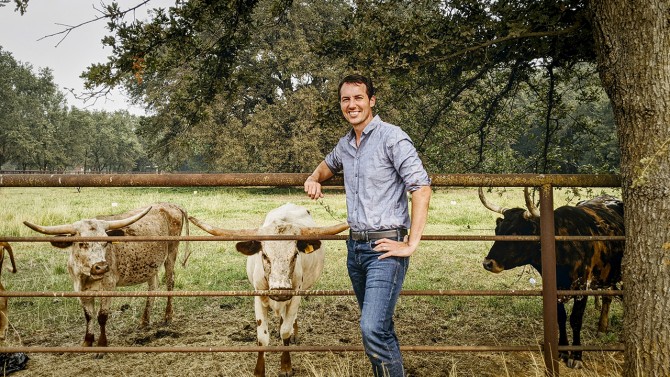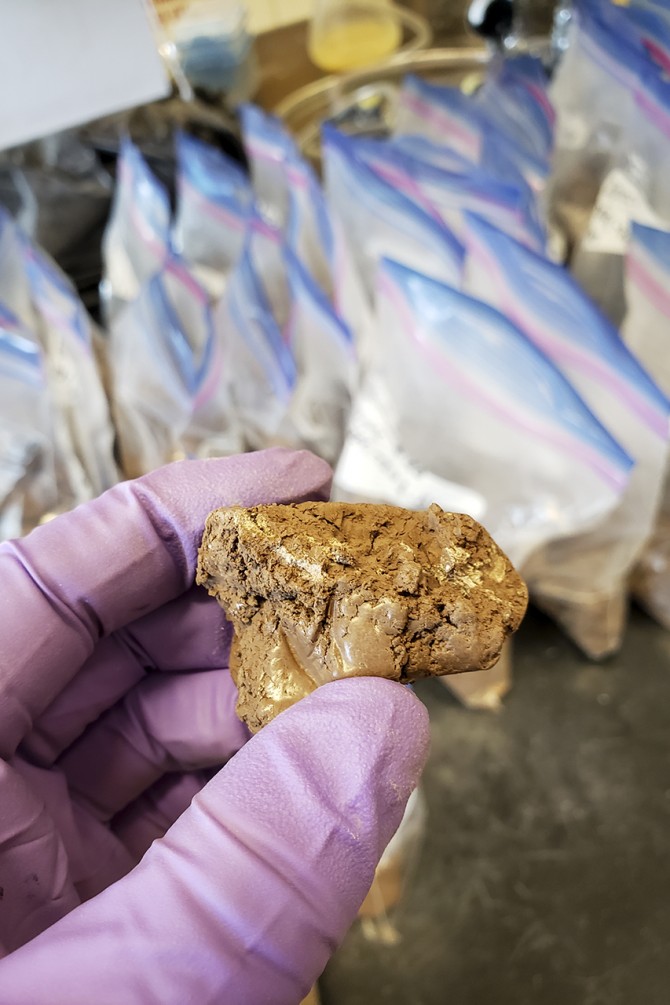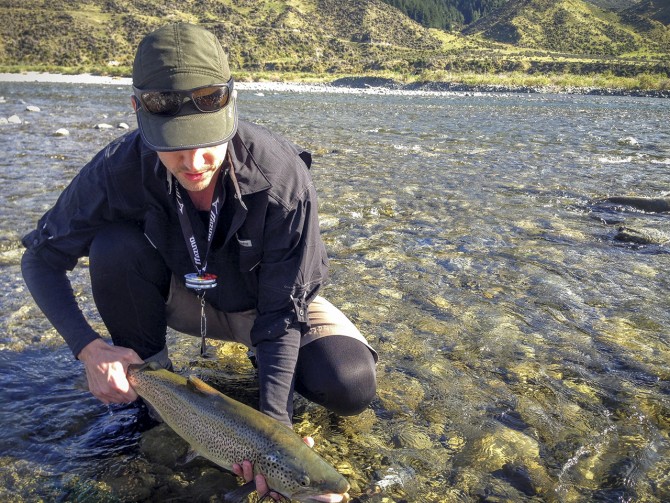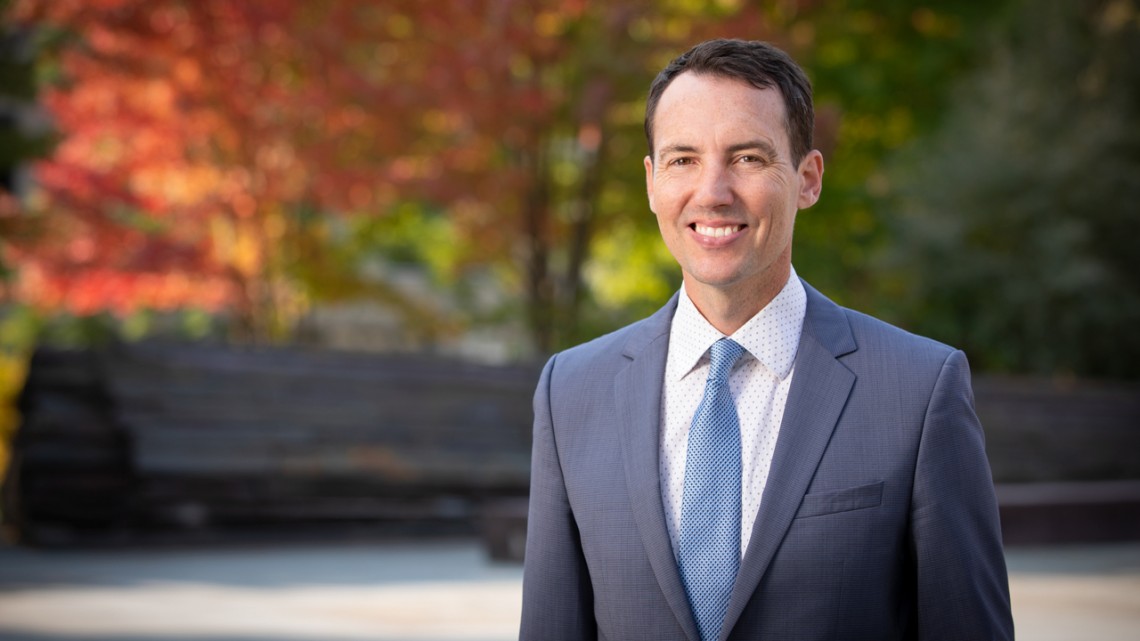
On Oct. 1, Benjamin Z. Houlton began a five-year term as the new Ronald P. Lynch Dean of the College of Agriculture and Life Sciences.
New CALS dean sees climate resilience in agriculture
By Jana Wiegand
On a clear morning in October 2019, Benjamin Z. Houlton stood at the edge of a corn field in California’s Central Valley. A truck drove back and forth along the tilled rows, sprinkling a special fertilizer over the ground – and setting in motion the largest soil amendment experiment of its kind in the world.
If all goes as planned, the addition of rock dust – rich in potassium, iron and zinc – will help increase the crop’s overall yield and nutrient density and will also sequester carbon dioxide (CO2) from the atmosphere.
“Each time these natural rock particles break down, they scavenge CO2 from the air, acting like sponges that securely lock that carbon into the soil for up to 100,000 years,” says Houlton, who on Oct. 1 began a five-year term as the new Ronald P. Lynch Dean of the College of Agriculture and Life Sciences. “It produces nutrient-dense food more efficiently. It increases farmers’ bottom lines. And it helps the global environment.”
Getting to this point required decades of research and years of dedicated outreach.
Houlton’s formula for success? Innovation, collaboration and carbon sequestration.
An ecosystem at odds
An accomplished environmental scientist, Houlton has published more than 130 academic papers. He is internationally recognized for his research on ecosystem processes and for creating collaborations that drive sustainable agriculture and energy production.
Formerly the director of the John Muir Institute of the Environment at the University of California, Davis, Houlton has been appointed a professor in the departments of Ecology and Evolutionary Biology and of Global Development, in addition to his new role as CALS dean.
Yet his connection to upstate New York dates back to the late 1990s.
Houlton received his master’s degree in environmental engineering science from Syracuse University. He then started his Ph.D. at Cornell, working with Lars Hedin, a professor in the Department of Ecology and Evolutionary Biology. Two months into his program, Hedin took a position at Princeton University. Houlton followed.
“The program was really fascinating,” Houlton says. “Lars was exploring these basic ecosystems, the complexity of nature and biogeochemical cycles, which is what my field ultimately ended up being.”
Their research took them to an ecosystem on the slopes of Mt. Haleakala – a shield volcano that makes up more than 75% of Maui, Hawaii. Over the span of two miles, the climate naturally changes from receiving a foot of rainfall per year to nearly 25 feet per year – producing one of the world’s most spectacular rain shadows. It was the perfect place to study how varying climates influence carbon and other nutrients cycling in tropical forests.
Nitrogen, Houlton noticed, played a key role in these complex interactions.
“For decades, scientists had observed a set of compelling patterns in many different ecosystems,” Houlton says. “It turns out that the bacteria that live in the soil and the way they create nitrogen gases leaves little fingerprints in the atomic mass ratio.”
Those minute interactions between nitrogen isotopes give rise to global-scale patterns, and Houlton devised a mathematical framework to analyze those dynamics.
“Through that really basic discovery, my collaborative program working with students and postdocs created a new benchmarking tool to calculate nitrogen’s substantial impact on the global climate system,” he says. “That has now influenced models being used by the Intergovernmental Panel on Climate Change.”
That research published in Nature Climate Change in 2015, after Houlton had been living in California for 10 years. He had been working at UC Davis since 2007.
Having cracked one climate code, Houlton decided to decipher another.
He says that understanding how much nitrogen – a key life ingredient – is available to vegetation has profound implications for how much carbon dioxide the world’s ecosystems can absorb.
For years, scientists had measured the nitrogen captured in different forest ecosystems by soil microbes and by rain. When they tallied the numbers, they realized that there was far more nitrogen accumulating in those regions than could be explained by atmospheric nitrogen alone.
Houlton’s team drove to the Klamath Mountains in Northern California to investigate a somewhat discarded theory: nitrogen might be leeching from sedimentary rocks as they weathered. They took soil samples from a conifer forest that had isolated sections of both sedimentary and igneous bedrock. Later analysis showed that the soil above the layered sedimentary rock contained 50% more nitrogen than the volcanic igneous rock.
The discovery sent Houlton’s graduate student running into his office. Not only did this finding provide a crucial clue in the mystery of the missing nitrogen, but it also meant that plants in these environments had more fuel at their disposal to help process surplus carbon in the atmosphere.
To see just how widespread this phenomenon might be, Houlton and his team spent the next several years compiling datasets from around the world, releasing their findings in Science in 2018.
The results rocked the scientific community: 25% of the nitrogen available to plants actually came from rock weathering.
Once again, Houlton helped rewrite the global models that describe Earth’s carbon cycle and climate change.
From one dairy state to another
Understanding humans’ relationship with the environment has long been a motivating factor for Houlton’s research. Growing up in southeastern Wisconsin, straddling the rural-urban divide between Milwaukee’s suburbs and the surrounding farmland, he always knew the two systems were intimately intertwined.
“In Wisconsin, you grow up with this built-in farming ethos,” he says. “Not only are farmers growing food, but they’re also creating culture. They’re stewards of the land.”
He spent time at his aunt and uncle’s dairy farm and volunteered at a local dairy in middle school. His family legacy in agriculture spans the dairy, poultry, grain and feed commodities, and still includes one remaining family dairy farm in Kansas. Says Houlton: “I like to say, if you shake my family tree, a dairy farmer falls off of every branch.”
Both of Houlton’s grandfathers grew up on dairy farms. With only an 8th-grade education, his grandfather Jerry Houlton managed a large dairy operation in Ohio before ultimately settling in Black River Falls, Wisconsin. There, Houlton’s father grew up working in poultry while Jerry ran grain and feed distribution.
“Farming is really in my DNA, on both sides for generations,” Houlton says, “and it has given me a deep appreciation for what agriculture does for society.”
The grand collaborations
Now that fall harvest is underway, Houlton’s research team is returning to the fields in California’s Central Valley. They will measure the change in yield and the amount of carbon absorbed by the 14 acres of corn and alfalfa that received the rock dust amendment last year, on fields operated by Bowles Farming Company.
As a sixth-generation farming operation near Los Banos, California, the Bowles family and their ancestors have been stewards of the land for more than 160 years. They grow crops ranging from tomatoes and peppers to almonds, melons and cotton.
“What I like about Ben’s approach is that it’s not just a trial that might work,” says Derek Azevedo, executive vice president of Bowles Farming Company. “This is a simple, practical, scalable application that could drive value to the environment, value to investors and value to the farm.”
The partnership formed thanks to Houlton’s efforts in launching the Working Lands Innovation Center (WLIC). In 2018, he received $5 million from California’s Strategic Growth Council to build the program, which operates through the John Muir Institute of the Environment, a product of the California Collaborative for Climate Change Solutions and the broader University of California system.
WLIC’s goal is to catalyze carbon sequestration efforts on agricultural lands by collaborating with university researchers, state agencies, industry, farmers, ranchers and Native American tribes.
“We have a lot of specialty crops in California – over 400 commodities,” says Steven Ostoja, director of the U.S. Department of Agriculture California Climate Hub and a fellow at the Muir Institute. “We’re looking at how amendments might help us pull carbon out of the atmosphere and into the soil so that we can try to achieve carbon neutrality targets.”
Not only is it a huge project, it’s also a pioneering one, Ostoja says. They hope to scale up the most promising practices, finding ways to adapt them to a wider variety of crops, ecosystems and land management operations.
While at CALS, Houlton will retain his role as the principal investigator for WLIC, and he plans to map opportunities for coast-to-coast collaborations.
Long-term commitment is essential for building – and keeping – people’s trust, says Beth Rose Middleton. She is a professor and chair of the Department of Native American Studies at UC Davis and a fellow at the Muir Institute, where she leads the Environmental Justice Project.
“With the Working Lands Innovation Center, we sat down very early on to think about how we could engage communities that had not previously been engaged in this type of work,” Middleton says. “Working with tribes really takes a lot of trust-building because of the historic relationship between tribes and universities and extractive research.”
After meeting with the Intertribal Agricultural Council, Houlton and Middleton connected with the Pauma Band of Luiseño Indians in San Diego County. The Pauma run a successful agricultural operation growing 160 acres of avocadoes and citrus. With the WLIC, they’re planning to run a soil amendment trial in their 40-acre no-till olive orchard.
Farming the future
From the roots of these solutions to the systems that govern them, Houlton has been thinking of ways to tackle not just climate change, but also the challenge of feeding 10 billion people by 2050.
“Agriculture is the most important industry of the 21st century,” Houlton says. “No industry is better prepared to solve global carbon issues than agriculture.”
At UC Davis, California’s land-grant institution, Houlton successfully launched the university’s One Climate Initiative in 2018. This strategic plan calls for a cross-campus carbon farming consortium that prioritizes research solutions and community outreach to achieve negative emissions.
“It’s a wonderful vision to include people from multiple disciplines and perspectives to address climate change,” says Middleton, who’s been an active participant in the initiative. “Being able to sit down with Ben and see his commitment to the interdisciplinary nature of that project is really inspiring to me.”
Now at New York state’s land-grant institution, Houlton hopes to plant the seed for more innovative collaborations.
“We need to bring research and development to the table to make sure we can perfect the research, get the knowledge out there and make it happen in a way that is economically viable for our farmers and ranchers,” he says. “We have to let Cornell partner with innovation and perfect that knowledge through mutual exchange.”
“If you think of the scope of climate change, it’s a really daunting problem,” Ostoja says. “But Ben understands, even with the limitations [of less developed countries], there is great opportunity. He looks for those win-wins – finding the silver lining around what often seems like a very dark cloud.”
Over the last four years, Ostoja has seen Houlton step into these conversations with a variety of stakeholders and emerge with new strategies and fresh support. Few people are so well-suited to tackle such complex problems, Ostoja says.
“Now, as dean of the College of Agriculture and Life Sciences, I have a responsibility to New York state agriculture,” Houlton said in a recent interview with David Fisher ’84, president of the New York Farm Bureau. “A responsibility to think about how we can get new science and research to the table to make farmers’ lives better and how we can learn what your real problems are so that we can break down barriers.”
An additional challenge, Houlton says, is increasing the diversity of people working in agricultural and environmental circles.
“That means getting people of color actively involved in careers in sustainability, in environment and in agriculture. New York can really lead in that area, I believe, and CALS can keep building on opportunities to diversify,” he says. “The goal is that everyone has access – equally.”
CALS is poised for pioneering purpose-driven science and delivering life-changing solutions to people across New York state and around the world, he added. By partnering with Cornell Cooperative Extension, engaging with farmers in both rural and urban communities, and inspiring stakeholders to support innovation, Houlton says the time is ripe for investing in new ways to build a better society.
And as soon as more people recognize agriculture as part of the solution – the defensive line for safeguarding biodiversity, food security, agricultural stability and climate resilience – the more readily they will support the solutions that CALS puts forward.
“We have to think of agriculture as part of the environmental system that produces food and many other goods and services for society,” Houlton says. “Food security – that is what gives rise to our ability to withstand pandemics, to withstand climate change, to withstand all the impacts to our economy. It’s the ultimate fabric that holds our society together.”
A version of this article appears on the CALS website.
Jana Wiegand is the editorial content manager for the College of Agriculture and Life Sciences.
Media Contact
Get Cornell news delivered right to your inbox.
Subscribe